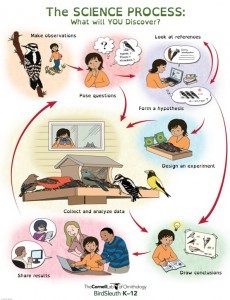Investigating Evidence Resources
If you use the Investigating Evidence curriculum, these resources will help you make the most of it!
Introduction: Meeting the Standards
Engage students in science practices while building English and math skills.
- For additional information on how Investigating Evidence specifically meets NGSS and Common Core math and ELA standards, check out this PDF document.
Investigation 1: Observe and Wonder
Science begins with curiosity and close observation.
- When taking your students outside to observe the natural world, consider following these outdoor teaching tips to help facilitate a great experience.
Investigation 2: What is Science?

Students will meet some of our Lab scientists and learn about the science process through their exciting work.
- Use the Crossing Boundaries young scientist videos. (If the video below does not show, try another internet browser.)
- Interested in chatting about science careers with your students? Here’s some information about Careers in Science from PBS and a listing of the Different Fields of Science from another site.
Investigation 3: My Investigation
Designing your own experiments is fun and demands creative thinking!
- These example rubrics (link coming soon) will help you develop a rubric for evaluating students’ investigations.
- A great way to get kids excited about planning and conducting their own investigations is to show them what other kids have done. Be sure to download BirdSleuth Investigator.
Investigation 4: Testing Hypotheses
It’s an exciting challenge to plan and implement your own investigation!
- This simple PowerPoint presentation, Variables in Science Experiments, will help you present the concepts of variables and controls to your students.
- Use the Hypothesis Help PowerPoint presentation to help your students learn how to craft a hypothesis from their observations and questions.
Investigation 5: Show Me the Data
- The Grackles Graphing PowerPoint presentation will help you make teaching graphing fun and easy.
Investigation 6: Share My Investigation
Sharing what you’ve learned is a critical part of the science process.
- Our BirdSleuth Investigator is full of examples of great student investigation reports for you to share with with students.
- Conduct your peer review, then congratulate your students on their research! Use one of these three Investigating Evidence rubrics to assess student reports. These are a Word document and you may want to add or remove assessment categories depending on what you’ve required of students. (For example, if you don’t require graphs or citations, you may want to leave those fields off; if you require a photo or diagram, you might want to add that to the rubric.)
Going further: new curriculum!
- Explore our newly updated science inquiry unit, Students as Scientists: Nature-based Inquiry, which is replacing Investigating Evidence.